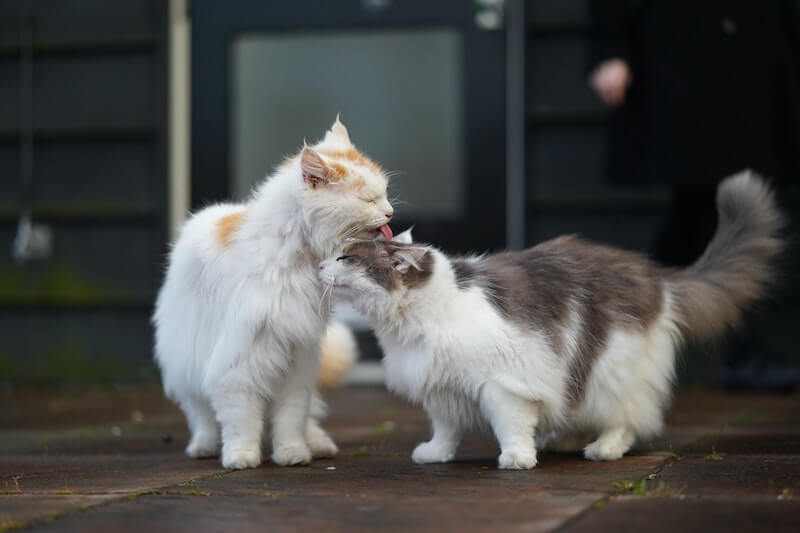With great cuteness comes great responsibility.
Cats are amazing. They’re gorgeous, clean, affectionate, compact, and pretty low-maintenance. But don’t be fooled: Just because they don’t require daily walks like their canine counterparts, doesn’t mean they don’t need lots of care and attention to live long and happy lives.
Before you choose a name, order a fancy litter box, and rush home with a furball of your very own, get the facts on the wonderful (and often hair-covered) world of cat ownership.
How much does it cost to own a cat?
You should be prepared to spend at least $50 a month on your cat.
To keep your cat happy and healthy, you’ll need to pay for:
- Food: ~$30 a month
- Litter: ~$10 a month
- Toys & treats: $5-$500 a month, depending on your budget and how indulgent you are. (If you need some cat toy inspiration, check out this pet gift guide.)
- Basic supplies like litter box, bowls, cat carrier, etc.: ~$100 one-time purchase
- Regular veterinary care: $300+ a year
The amount you spend on your furry friend can vary dramatically based on your cat’s needs. For example, your cat might suffer from allergic reactions that require them to eat special food. Or if your cat is injured in an accident, an unplanned trip to the vet could set you back several hundred dollars.
There are plenty of effective ways to save money on your cat’s care. Because dry and canned cat food is shelf stable, you can buy your cat’s food in bulk and save money in the long run.
There are also a variety of litter options: traditional sand, silica crystals, and flushable organic litter to name a few. Sand is definitely the cheapest option, but it might need to be replaced more often than crystal litter. Take some time to find the right balance that works for your wallet, your nose, and your kitty. (If you’re really looking to save, the cheapest option is definitely training your cat to use the toilet.)

When it comes to veterinary costs, an easy way to save (and avoid being bankrupted by major procedures for your fur fam) is by taking out a cat insurance policy. With pet insurance companies like Lemonade, you pay a monthly premium, after which your insurer would pay up to 90% of the costs for eligible treatments. That’s a lot of catnip.
It’s worth noting that as your cat ages, they will require more veterinary care and treatments, which is why it pays to take out a pet insurance policy on your cat as early as possible. If you try to sign your 11-year-old cat up for insurance for the first time, they might be declined due to their age; either way, they’re likely to have pre-existing conditions that won’t be covered by insurance. But if you get your new kitten a Lemonade policy right away, they’ll never be denied coverage because of their age.
Where should you get your cat?
When it comes to cats, sometimes they just choose you.
A street cat might follow you home from work (you ate a tuna sandwich), and voila! You’re a cat owner. Or your neighbor’s cat will have an accidental litter of kittens, and you decide to take a pair off their hands.
But more often than not, you’ll need to go to a local shelter, breeder, or rescue to find your future feline.
If you go the rescue route…
Do your research on the shelter (or individual rescuer!). What are the cats’ living conditions like? Are their veterinary needs being met? Does the rescue work to swiftly match cats with suitable homes?
If your future kitty was well-taken care of in their previous living situation, it will set them up for happiness and health once you welcome them into your home. Otherwise, you could be dealing with challenging, long-term health and behavioral issues.
No matter where your new cat is coming from, it’s always a good idea to schedule a short meet-and-greet visit in advance to get to know your potential kitty. This way, you can get a sense of the cat’s living conditions and ask questions about their veterinary care, all while getting a feel for your future kitty’s unique personality.
TIP: Volunteering with a shelter or fostering could be one way to get to know a cat before taking the leap to adoption. If all goes well, it might end up as a ‘foster fail’—the term for when a temporary pet ends up becoming a forever friend.
If you go with a breeder…
Some breeders are passionate and loving cat-enthusiasts. Others might only be in it for the money. (Google is your friend here.) If you’re looking to buy a particular breed of cat, choose a breeder who is knowledgeable about cat veterinary and developmental care, and who spends time socializing and playing with each kitten in their litters.
One huge red flag: If the breeder has multiple litters at once for you to choose from, it’s unlikely that all of the kittens (and their poor mommies) are getting the care, affection, and treatment they deserve.
Should you adopt a kitten or an adult cat?
The age of the cat you bring home can determine how much time, energy, and money you’ll be spending to make your feline family member feel at home.
There’s no denying the cuteness factor of kittens. They are small, clumsy, and fluffy. Kittens are delicate and require lots of attention, care, and clean-up.
If you’re adopting an itty-bitty kitten, you’ll be responsible for setting up her life for success. This means organizing initial vaccinations (~$300), spaying/neutering ($200-$1,200), microchipping ($50), and securing some space in your home where she can easily stay out of trouble. This can also mean guiding her through using the litter box, which can get… messy.
If your kitten would often be left home alone for extended periods of time or if you have small children who might not be gentle with her, it might make more sense to opt for a fully grown cat.

Adult cats are much more set in their ways. They generally know how to use the litter box, and they’ve fully come into their feline independence. This doesn’t mean your adult cat won’t love to cuddle, it just means that getting adjusted to a new home might take him some time.
In addition, if your cat has some bad habits like excessive scratching, biting, or spraying, it might take training (read: patience) to set new behaviors.
And whether you bring home a kitten or an adult cat, you’ll want to accept that some of your belongings—like that pristine leather couch—might end up falling prey to your furry friend’s claws. But, between us, the right scratching post can go a long way.
Is it OK to only have one cat, or are they better in pairs?
In a lot of cases, two cats might be the way to go.
Cats may be stereotyped as anti-social and aloof, but deep-down, under all that fur, they’re naturally social creatures who just want to create a lion pride of their very own.
When you’re exploring your cat adoption options, you might find that there are pairs of kitties who are kept in the same cage or who never stray too far away from one another. These cats are a bonded pair.
These special relationships can be formed between siblings from the same litter, or two unrelated cats who are brought together by fate from a young age. Responsible shelters and breeders will do anything in their power to ensure bonded pairs are adopted out together.
By adopting two cats, you are giving both of them built-in entertainment, affection, grooming and mental stimulation.
Some people find that when there is more than one cat in a house, the kitties are less likely to cause a ruckus or wake up their owners in the middle of the night. As far as the costs and care for two cats, you’ll need to double-up on veterinary expenses (pet insurance can help with that!), but two cats are usually happy to use the same litter box, play with the same toys and, in some cases, even eat from the same bowl.

But what if you really only want one cat?
That’s totally fine!
There are some cats that would rather go solo. This could be because of their own unique personalities or because of their upbringing. For example, it might be tough for an adult cat who has never had a sibling to adjust to a multiple-cat household.
In general, bringing home a solo adult cat is no problem. Be clear with the shelter, breeder, or rescue you’re working with, and they should be able to match you with a cat who would rather have the house to himself.
When it comes to kittens though, the shelter, rescue, or breeder may insist you adopt two at a time, or might confirm with you that there are other cats waiting for your new addition at home.
One meow thing…
Becoming a cat parent (or a full-blown cat person) can add some much needed comfort, fun, and snuggles during these uncertain times. After a year of stay-at-home orders and quarantines, we can agree: We’re all house cats now. Why not just go all the way and bring home an actual cat (or two) of your very own?
Before you take on the responsibility of cat ownership, make sure your lifestyle, schedule, and budget can provide the best life possible for this furry bundle of joy.
Do you feel stable enough to commit to caring for them for the long haul, after the pandemic has subsided? Maybe you love to travel, but haven’t left town for the past 12 months… well, you’re going to have to rethink that three-month European dream journey you’ve been planning if a new furry friend is depending on you.
And hey, if you’re ready to take your kitty home—consider getting your feline pal hooked up with Lemonade’s pet health insurance.
Once you’re all set, it’s time to snuggle up with your new kitty and start making some biscuits.




